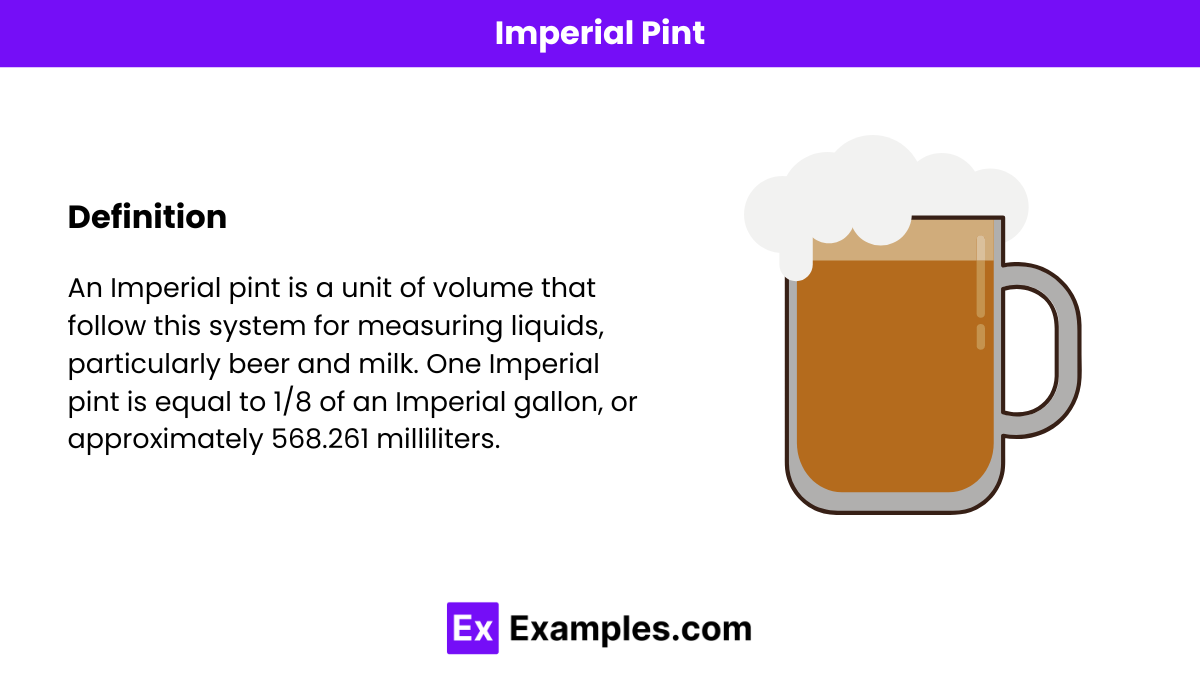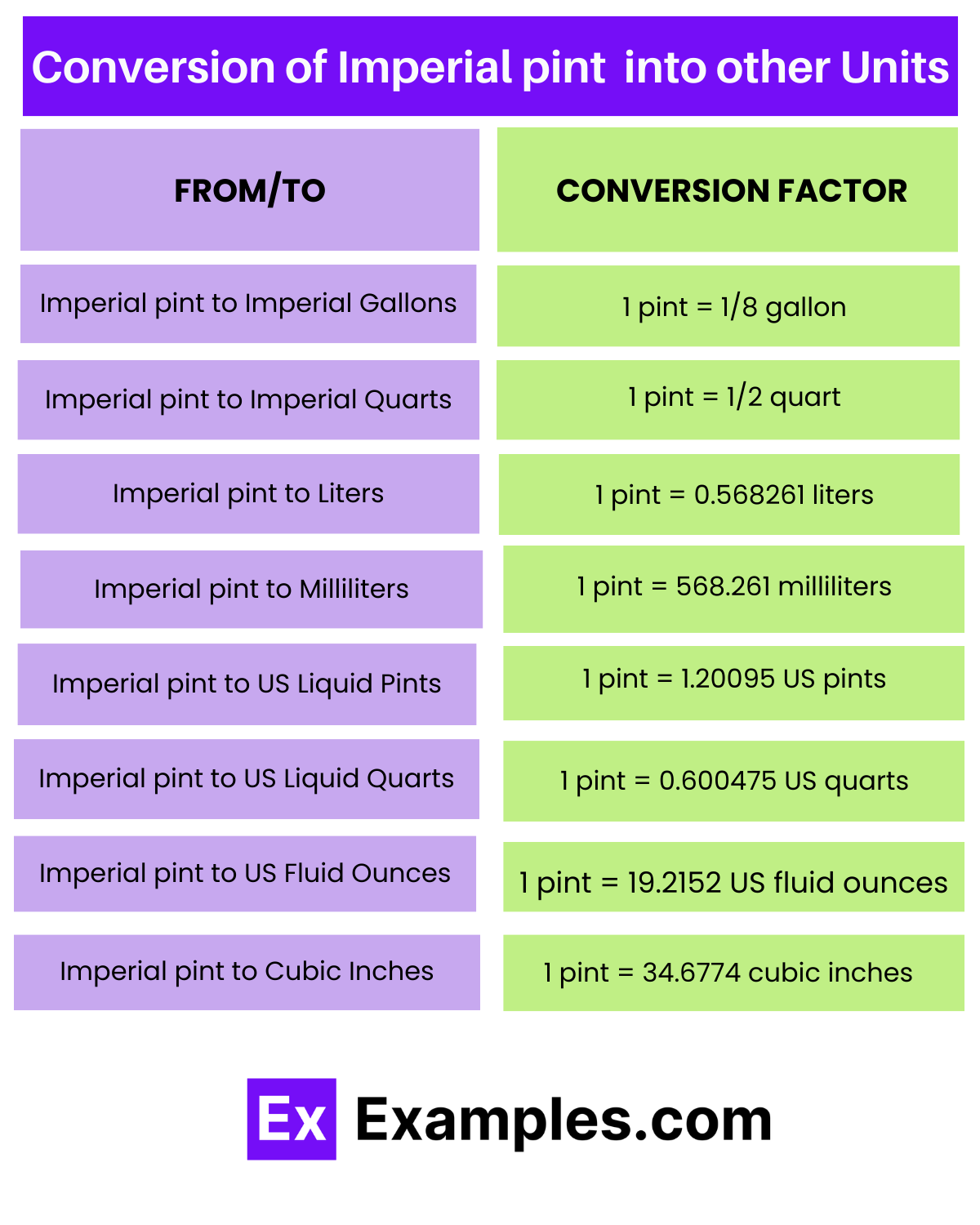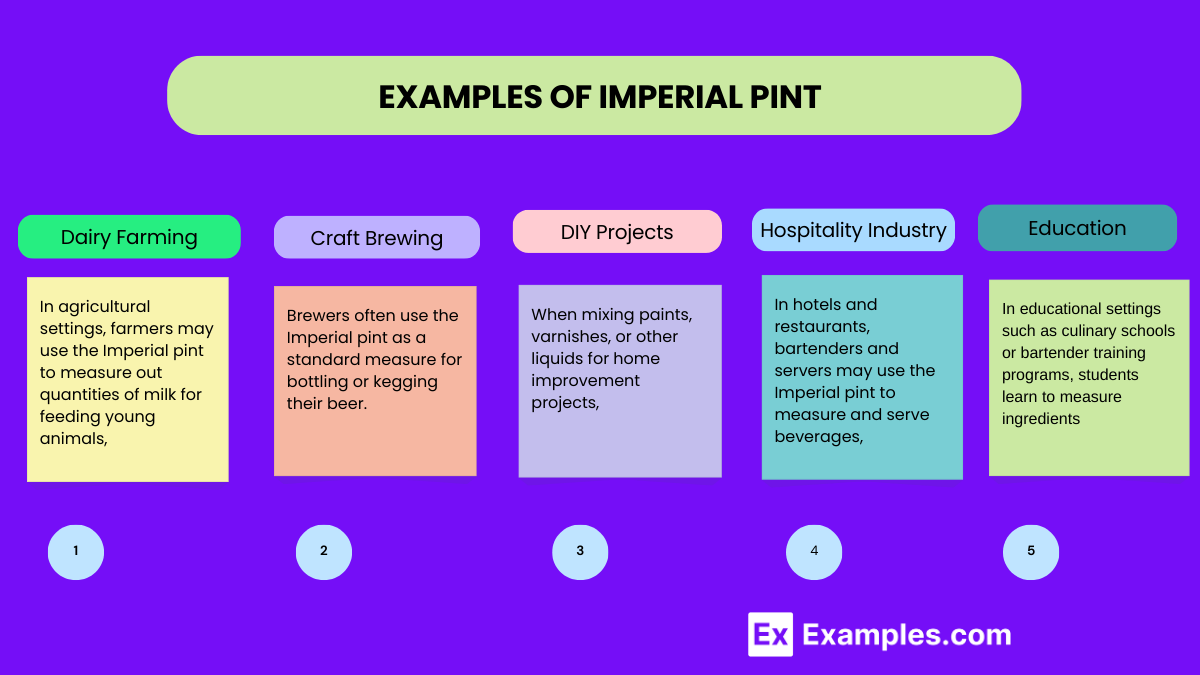How many fluid ounces are in an imperial pint?
16
20
25
30


An Imperial pint is a unit of volume in the British Imperial measurement system. It is commonly used in the UK and other countries that follow this system for measuring liquids, particularly beer and milk. One Imperial pint is equal to 1/8 of an Imperial gallon, or approximately 568.261 milliliters. This makes it larger than the US pint, which is about 473 milliliters.

| From Unit | To Unit | Conversion Formula |
|---|---|---|
| Imperial Pint | Imperial Gallons | 1 pint = 1/8 gallon |
| Imperial Pint | Imperial Quarts | 1 pint = 1/2 quart |
| Imperial Pint | Liters | 1 pint = 0.568261 liters |
| Imperial Pint | Milliliters | 1 pint = 568.261 milliliters |
| Imperial Pint | US Liquid Pints | 1 pint = 1.20095 US pints |
| Imperial Pint | US Liquid Quarts | 1 pint = 0.600475 US quarts |
| Imperial Pint | US Fluid Ounces | 1 pint = 19.2152 US fluid ounces |
| Imperial Pint | Cubic Inches | 1 pint = 34.6774 cubic inches |
One Imperial pint is equivalent to 1/8 of an Imperial gallon. This is useful in large-scale liquid measurements such as fuel and industrial fluids in countries using the Imperial system.
One Imperial pint equals 1/2 of an Imperial quart. This conversion is common in cooking and beverage serving in the UK and other countries that use the Imperial system.
To convert an Imperial pint to liters, multiply the number of pints by 0.568261. This conversion is essential for scientific and medical applications where precision is crucial.
One Imperial pint converts to 568.261 milliliters. This unit is particularly useful in culinary measurements and for specifying fluid quantities in recipes.
An Imperial pint is equivalent to approximately 1.20095 US pints. This conversion is handy when using British recipes in the United States.
An Imperial pint is about 0.600475 US quarts. This conversion can be useful in industries that require accurate fluid conversions between the two systems.
Converting an Imperial pint gives you 19.2152 US fluid ounces. This is often used in beverage industries and bar settings for serving sizes.
One Imperial pint is equal to 34.6774 cubic inches. This measurement is occasionally used in engineering fields where volume measurements are needed in cubic dimensions.

1.Dairy Farming: In agricultural settings, farmers may use the Imperial pint to measure out quantities of milk for feeding young animals, ensuring they receive the appropriate amount of nutrition.
2.Craft Brewing: Brewers often use the Imperial pint as a standard measure for bottling or kegging their beer. It helps maintain consistency in serving sizes and allows customers to enjoy a full pint of their favorite brew.
3.DIY Projects: When mixing paints, varnishes, or other liquids for home improvement projects, individuals might refer to the Imperial pint to ensure accurate measurements and achieve the desired results.
4.Hospitality Industry: In hotels and restaurants, bartenders and servers may use the Imperial pint to measure and serve beverages, ensuring customers receive the correct portion size and maintaining consistency in service.
5.Education and Training: In educational settings such as culinary schools or bartender training programs, students learn to measure ingredients and pour drinks using the Imperial pint as part of their practical training.
These examples highlight how the Imperial pint continues to play a role in various industries and everyday activities, serving as a practical unit of measurement in diverse contexts.
| Aspect | US Liquid Pint | Imperial Pint |
|---|---|---|
| Volume | Approximately 473.176 milliliters | Approximately 568.261 milliliters |
| Measurement System | US customary system | British Imperial system |
| Conversion Factor | 1 Imperial pint ≈ 1.20095 US pints | 1 US liquid pint ≈ 0.832674 Imperial pints |
| Usage | Commonly used in the United States for cooking, serving beverages, etc. | Historically used in the UK, less common today |
| Cultural Significance | Deeply ingrained in American culture, commonly referenced in recipes and everyday conversation | Reflects historical heritage in the UK and other Commonwealth countries |
This comparison outlines the key differences between the US liquid pint and the Imperial pint in terms of volume, measurement system, conversion factor, usage, and cultural significance.
The Imperial pint, a unit of volume in the British Imperial system, serves several practical purposes across different fields. Here are some common uses:
Beverage Serving: In British pubs and bars, the Imperial pint is commonly used to serve beer, cider, and other beverages. It provides a standard serving size and is a familiar measure for patrons.
Cooking and Baking: The Imperial pint is often referenced in recipes, especially in the UK, for measuring liquids such as milk, cream, broth, and sauces. It helps ensure accurate ingredient quantities for successful cooking and baking.
Dairy Products: Milk and cream are frequently sold in pints in the UK. Consumers are accustomed to purchasing these dairy products in Imperial pint quantities from supermarkets and grocery stores.
Home Brewing: Homebrewers may use the Imperial pint as a standard measure when brewing beer or other beverages. It helps maintain consistency and accuracy in recipe formulation and brewing processes.
Cultural References: The Imperial pint carries cultural significance in British society and is often referenced in literature, films, and everyday conversation. It symbolizes British drinking traditions and social customs.
Historical Context: The Imperial pint has historical roots dating back to the British Imperial system. Its usage provides a connection to the country’s heritage and traditional measurement practices.
Overall, the Imperial pint remains a relevant and widely used unit of measurement in the UK, particularly in hospitality, culinary, and cultural settings.
The Imperial pint is a unit of volume measurement in the British Imperial system. It is equivalent to approximately 568.261 milliliters or 20 fluid ounces. This measurement is commonly used in the United Kingdom for serving beverages, particularly beer, cider, and other drinks in pubs and bars.
Imperial pints are bigger than US liquid pints due to differences in the measurement systems. An Imperial pint is approximately 20 fluid ounces or 568.261 milliliters, while a US liquid pint is around 16 fluid ounces or 473.176 milliliters.
No, an Imperial pint is not the same as a US pint. The Imperial pint is a unit of volume measurement in the British Imperial system, equivalent to approximately 20 fluid ounces or 568.261 milliliters. On the other hand, the US pint is a unit of volume measurement in the US customary system, equivalent to approximately 16 fluid ounces or 473.176 milliliters.
Text prompt
Add Tone
10 Examples of Public speaking
20 Examples of Gas lighting
How many fluid ounces are in an imperial pint?
16
20
25
30
Convert 3 imperial pints to fluid ounces.
50
60
70
80
Which is larger, an imperial pint or a US pint?
Imperial pint
US pint
Both are the same
It depends on the liquid
How many cups are in an imperial pint?
1
1.5
2
2.5
If you have 5 imperial pints, how many liters do you have?
1.42 liters
2.84 liters
3.55 liters
4.73 liters
How many milliliters are in an imperial pint?
473 ml
500 ml
568 ml
600 ml
Which country primarily uses the imperial pint as a unit of measurement?
United States
Canada
United Kingdom
Australia
Convert 8 imperial pints to quarts.
2
3
4
5
How many imperial pints are in a gallon?
2
4
6
8
What is the volume of 10 imperial pints in liters?
5.68 liters
6.28 liters
7.38 liters
8.48 liters
Before you leave, take our quick quiz to enhance your learning!

